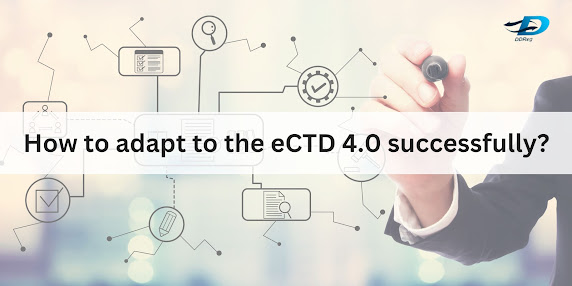How to adapt to the eCTD 4.0 successfully?
Pharma regulatory affairs is centered around
the common technical document (CTD) that is required for the registration of
pharmaceutical products in all markets. In more recent times the shift from the
CTD to the electronic CTD (eCTD) is being adopted by regulatory agencies worldwide
to overcome challenges associated with large amounts of paper-based data and to
help facilitate more harmonized and efficient submissions. This is because it
enhances review and submission processes, results in more accurate &
precise submissions, mitigates duplicate submissions (due to better document
organization), and implements a single, standard format that is accepted
worldwide.
Implementing the eCTD 4.0
What is the eCTD 4.0?
The eCTD 4.0 is the most recent eCTD
standard that address some of the key limitations. It’s main goals are to
implement changes that accelerate and maximize the efficiency of regulatory
submissions; enhance the communication channel between sponsors and regulatory
agencies; and more importantly improve the global harmonization of the eCTD
format. While some regulatory agencies have already implemented the pilot
version, others are still due to accept the eCTD 4.0.
However, organizations that are more
familiar with paper-based submission establishments face challenges when making
this shift. So, what are some ways in which the eCTD 4.0 can easily be adopted?
Things to consider for easy adaptation
of the eCTD 4.0
Gap Analysis and implementation plan
It is important to reflect on the current
systems and processes in place for regulatory submissions. A gap analysis
should be conducted to detect any deficiencies, areas that require improvement,
and review key internal procedures to ensure that they are maintaining
compliance with the eCTD 4.0 standards. Partnering with a regulatory service
provider that has the experience and knowledge of the most recent standards can
be beneficial in conducting an effective gap analysis.
A plan must be created and implemented once
all the gaps have been identified. These would ideally incorporate relevant
timelines as well as a plan that facilitates communication between all teams
such as publishing, regulatory
affairs, IT, etc.
Data consistency and software validation
It is imperative for data to be of high
quality and consistent throughout the eCTD 4.0 submissions. Hence, teams must
ensure that the information is accurate and consistent along documents and
sections within these documents.
It is important to ensure that submissions maintain compliance with ICH standards. The eCTD version 4.0 includes validation criteria that checks for this. Thus, regulatory consulting organizations recommend validation software to help make sure that compliance with ICH standards is being met and reduce any risk of submission rejection by the regulatory authority.
Additionally, it is important to ensure
that all staff and stakeholders associated with the eCTD 4.0 are trained
regulatory on the submission procedure, the technical know-how, and are
apprised on the importance of high quality data to facilitate the transition to
eCTD 4.0. Following adoption of the eCTD 4.0., it is crucial to observe and
assess the 4.0 submission processes on a regular basis.
Conclusion
In order to strategically and effectively
adopt the eCTD 4.0 standard, organizations must give time and develop a
strategic & comprehensive approach that starts from identifying gaps to
constant evaluation of the eCTD 4.0 submissions. Partnering with experts in the
field can help support the transition to the new standard which provides regulatory solutions to
some of the challenges faced by organizations that rely on paper-based
submissions.


Comments
Post a Comment